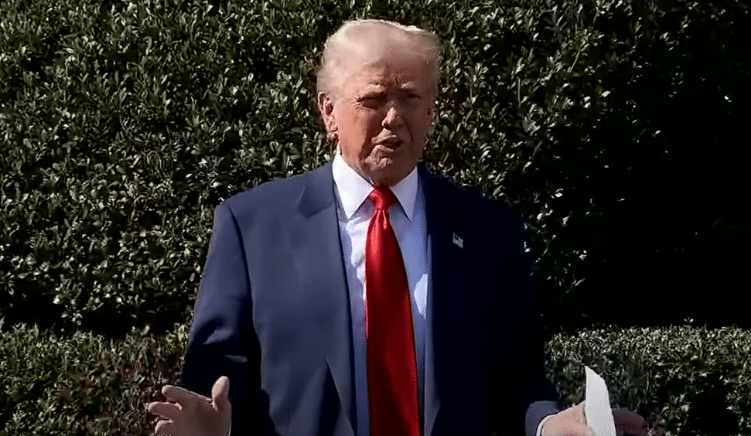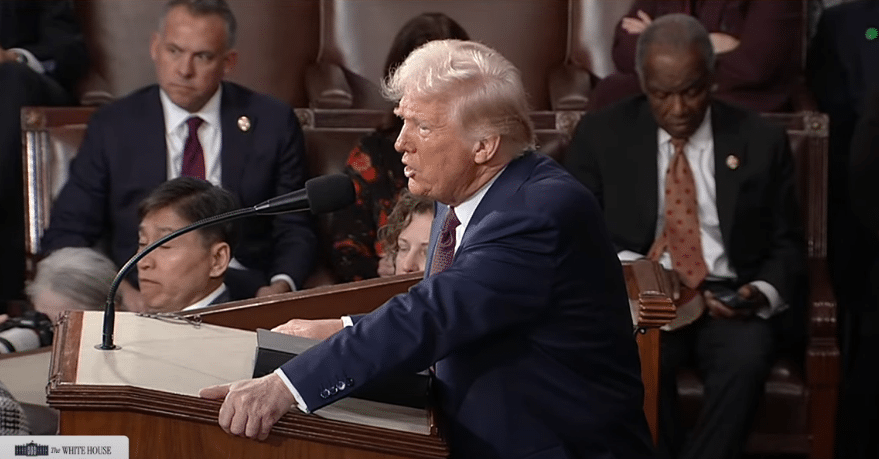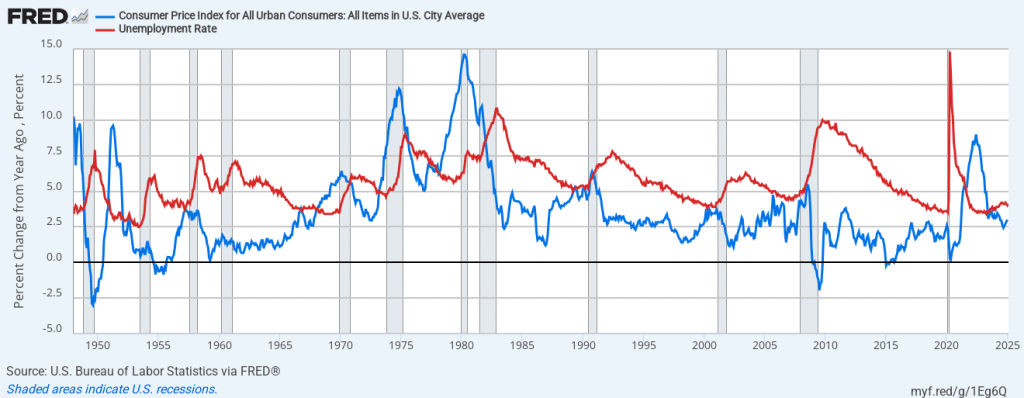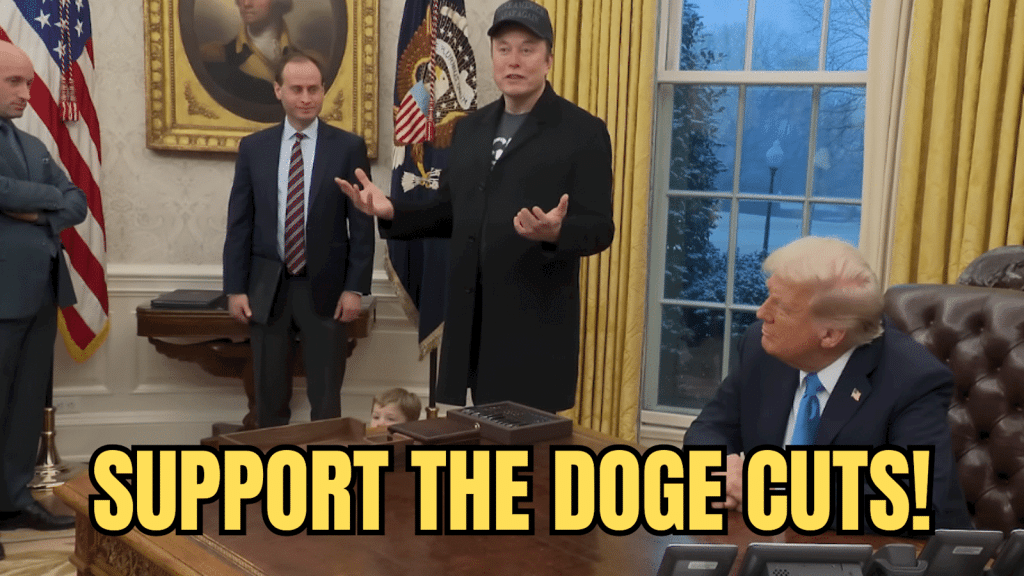
March 12, 2025
Permission to republish original opeds and cartoons granted.
Inflation Cools In February In Spite Of Trump Tariffs, Bewildering Democrats Who Had Predicted Higher Prices
| 
|
|
Inflation slowed down in February to 0.2 percent monthly, or a 2.8 percent annual increase, according to the latest data by the Bureau of Labor Statistics, defying predictions by President Donald Trump’s political opponents that President’s tariff policies taking effect would immediately cause inflation to speed up. On just March 2, Senate Minority Leader Chuck Schumer (D-N.Y.) boldly predicted, “President Trump’s tariffs are going to raise prices on families by as much as $1,200 per year.” On March 11, just yesterday, Schumer declared, “inflation has gone up under Donald Trump, from groceries to retail to cars.” Democrats bet — wrongly, as it turned out — that inflation would accelerate. Whoops. Instead, inflation appears to be decelerating, with food at home — the food Americans buy at grocery stores — did not grow at all, at 0 percent. New cars decreased 0.1 percent. Gasoline decreased 1 percent. And transportation services decreased 0.8 percent. Inflation hit 7.5 percent by Jan. 2022 and peaking at 9.1 percent in June 2022 as production failed to catch up after the Covid economic lockdowns of 2020 and 2021, and the federal government printed, borrowed and spent almost $7 trillion. As that happened, the U.S. economy overheated, with the growth of consumer credit plunging even as labor markets reached maximum employment. But then, as has happened in every single economic cycle in the postwar period, as inflation slowed down, predictably, unemployment increased, up now by 1.3 million since Jan. 2023 to more than 7 million. All of which contributed to Democrats’ defeat in the 2024 elections as Trump won and Republicans secured majorities in the House and Senate. It had nothing to do with tariffs. |
Trump’s Tax Cuts Benefited The Middle-Class And That Is Why Extending Them Is Wildly Popular
| 
|
|
The Tax Cuts and Jobs Act, which Trump heavily pushed for and signed into law in 2017, slashed corporate taxes from 35% to 21%, and delivered one of the most robust economies in modern history during Trump's first term. Trump’s tax cuts also drastically slashed the tax rate for small businesses and independent contractors by including a “pass through deduction” that allowed middle-class self-employed individuals to deduct 20 percent of qualified business income. Under the pass-through deduction, the effective top individual tax rate on business income was slashed from 37 percent to 29.6 percent, a massive victory for small businesses. Individuals and families also saw their tax rates drop. While the lowest tax rate remained at 10 percent, the middle-income tax rates dropped between one and four percent – offering middle-class families substantial savings. The Trump tax cuts also nearly doubled the standard deductions for individuals and families, raising the deduction for individuals from $6,500 to $12,000 and for families from $13,000 to $24,000. However, the cuts are on the chopping block to expire at the end of this year if Congress doesn’t act to extend them. YouGov polling shows that close to two-thirds of Americans want the president and Congress to extend Trump’s tax cuts, with Americans saying 62 percent to 38 percent Congress should act to renew the tax cuts. |
Urge Congress To Suspend Impoundment Control Act Through Dec. 2026 and Authorize DOGE Cuts!
| 
|
|
The Impoundment Control Act negated about 170 years of precedent wherein presidents had the absolute Article II executive authority to not spend funds authorized by Congress when they deemed such spending unnecessary, starting with Thomas Jefferson all the way through Richard Nixon. Besides recessions and wars, the result was relatively sound fiscal policy. The stunning findings of the White House Department of Government Efficiency of waste and theft of taxpayer resources requires that President Trump do what is necessary to end that waste and theft. Congress cannot be expected to guess how much and where the waste and theft is occurring. Only the President has that ability in administering the laws. Suspending the unconstitutional Impoundment Control Act until Dec. 31, 2026 could reduce the deficit by as much as $1 trillion. Importantly, this would alter the current projected spending baselines by incorporating the savings now being touted by the White House. |
Inflation Cools In February In Spite Of Trump Tariffs, Bewildering Democrats Who Had Predicted Higher Prices

By Robert Romano
Inflation slowed down in February to 0.2 percent monthly, or a 2.8 percent annual increase, according to the latest data by the Bureau of Labor Statistics, defying predictions by President Donald Trump’s political opponents that President’s tariff policies taking effect would immediately cause inflation to speed up.
On just March 2, Senate Minority Leader Chuck Schumer (D-N.Y.) boldly predicted, “President Trump’s tariffs are going to raise prices on families by as much as $1,200 per year.”
On March 11, just yesterday, Schumer declared, “inflation has gone up under Donald Trump, from groceries to retail to cars.” (See below: Both groceries and cars didn’t experience any price increases in February, the first full month of Trump’s presidency.)
On Feb. 1, House Minority Leader Hakeem Jeffries (D-N.Y.) similarly suggested that prices would go up, stating, “The tariffs imposed by the administration and strongly supported by House Republicans will not lower the high cost of living for everyday Americans. Instead, it will likely do the exact opposite and make life more expensive.”
On March 3, Sen. Elizabeth Warren (D-Mass.) also projected price hikes, saying, “Donald Trump promised on ‘Day 1’ to lower costs, but instead working families now have to worry about giant corporations using his haphazard tariff announcements as an excuse to raise prices – and the Trump Administration has no plan to stop it.”
You could go on and on. Political parties in legislatures including Congress coordinate their talking points to provide consistent messaging and proclamations about how they see the state of affairs, and in opposition, usually outline worst case scenarios that the White House incumbent’s policies, in this case Trump, might lead to.
In this case, Democrats bet — wrongly, as it turned out — that inflation would accelerate. Whoops.
Instead, inflation appears to be decelerating, from 3 percent annualized in January to 2.8 percent in February.
Food at home—the food Americans buy at grocery stores — did not grow at all, at 0 percent.
Gasoline decreased 1 percent.
New cars decreased 0.1 percent.
And transportation services decreased 0.8 percent.
There are still some mixed signals. For example, electricity increased another 1 percent and piped gas utility service was up 2.5 percent. By and large, though, electricity and heating services including natural gas are domestically produced.
Still, the picture of cooling inflation is exactly what one would expect to see towards the end of an economic cycle, particularly following a large increase in inflation the U.S. experienced in 2021 and 2022.
Inflation hit 7.5 percent by Jan. 2022 and peaking at 9.1 percent in June 2022 as production failed to catch up after the Covid economic lockdowns of 2020 and 2021, and the federal government printed, borrowed and spent almost $7 trillion.
As that happened, the U.S. economy overheated, with the growth of consumer credit plunging even as labor markets reached maximum employment. But then, as has happened in every single economic cycle in the postwar period, as inflation slowed down, predictably, unemployment increased, up now by 1.3 million since Jan. 2023 to more than 7 million.

All of which contributed to Democrats’ defeat in the 2024 elections as Trump won and Republicans secured majorities in the House and Senate.
It has nothing to do with tariffs. For example, former President Joe Biden left Trump’s tariffs on China in place throughout his presidency, and China left its tariffs on U.S. goods in place.
During the Biden years, we saw prices start out low, then accelerate, not because of tariffs, but because of global supply chain issues and monetary and fiscal stimulus after Covid, and then slow down as the economy overheated. Nothing to do with the taxes levied on imported goods by either country.
To be certain, after so much inflation, the global economy does appear to be slowing down, too.
For example, in India, inflation in February slowed to 3.6 percent, a seven-month low and below market expectations, amid cooling there as well, which again, is irrespective of tariff rates. India charges very high tariffs for goods shipped to their 1.45 billion population — 18 percent of the global population — but that has neither driven the global economy up nor down.
So, if inflation is cooling here, and it is cooling in India — and everywhere else — in spite of minor changes to tariff policies, then the global economy is simply slowing down after overheating for the past three years. That’s it. Maybe next time speed up production faster and don’t print so much money for a recession.
In the meantime, domestically, undoubtedly Trump’s opponents will now pivot from talking about higher prices to talking about a recession even though a recession signals have been flashing red for months and years. The partisan analyses too are normal, but it can also be noise that might not take into account the long term factors that impact items like inflation, unemployment and overall growth.
Instead, what we might be learning is that President Trump’s tariffs, coming at a time when prices are cooling and the economy is perhaps slowing, could actually represent very well-timed policy to reorient U.S. trade policies. But we are also learning that after the inflation of the Biden years, Trump has inherited a crappy economy that might be due for another recession. Stay tuned.
Robert Romano is the Vice President of Public Policy at Americans for Limited Government Foundation.
To view online: https://dailytorch.com/2025/03/inflation-cools-in-february-in-spite-of-trump-tariffs-bewildering-democrats-who-had-predicted-higher-prices/
Trump’s Tax Cuts Benefited The Middle-Class And That Is Why Extending Them Is Wildly Popular

By Manzanita Miller
President Donald Trump’s approach to economic growth relies on a multifaceted approach that includes reducing wasteful federal spending, placing tariffs on foreign goods, and perhaps most significantly, extending the sweeping slate of tax cuts he implemented in his first term for all Americans.
Those tax cuts, which Americans have been benefiting from for the past seven years, are set to expire unless Congress acts to extend them, and President Trump is working overtime to ensure they remain in place.
The president’s approach to economic growth also relies heavily on auditing the federal government and eliminating wasteful and fraudulent spending. Trump has been persistently working to audit the federal government with the help of the Department of Government Efficiency (DOGE) team, showing every attempt to offset the cost of tax cuts for American families.
On March 10, Trump also signaled his support for a continuing resolution that would freeze discretionary spending but continue to fund the government through Sept. 30, 2025.
Trump’s focus on reducing federal spending while slashing taxes is wildly popular among the public, with close to two-thirds of voters favoring extending his tax cuts and Americans saying by 45 points the federal government should reduce spending according to recent YouGov data.
Here is what’s at stake. The Tax Cuts and Jobs Act, which Trump heavily pushed for and signed into law in 2017, slashed corporate taxes from 35% to 21%, and delivered one of the most robust economies in modern history during Trump's first term.
Trump’s tax cuts also drastically slashed the tax rate for small businesses and independent contractors by including a “pass through deduction” that allowed middle-class self-employed individuals to deduct 20 percent of qualified business income.
Under the pass-through deduction, the effective top individual tax rate on business income was slashed from 37 percent to 29.6 percent, a massive victory for small businesses.
Individuals and families also saw their tax rates drop. While the lowest tax rate remained at 10 percent, the middle-income tax rates dropped between one and four percent – offering middle-class families substantial savings.
The Trump tax cuts also nearly doubled the standard deductions for individuals and families, raising the deduction for individuals from $6,500 to $12,000 and for families from $13,000 to $24,000.
However, the cuts are on the chopping block to expire at the end of this year if Congress doesn’t act to extend them.
YouGov polling shows that close to two-thirds of Americans want the president and Congress to extend Trump’s tax cuts, with Americans saying 62 percent to 38 percent Congress should act to renew the tax cuts.
There is broad bipartisan support for extending Trump’s tax cuts, although Democrats oppose extending them by 22 points. Independents support extending Trump’s tax cuts by 20 points, 60 percent to 40 percent, and Republicans support extending the tax cuts by 72 points, 86 percent to 14 percent. While a majority of Democrats reject extending Trump’s Tax cuts – 61 percent – a full 39 percent of Democrats also support extending Trump’s tax cuts.
Americans also strongly support Trumps efforts to offset the tax cuts with a reduction in wasteful federal spending. By a broad 45-point margin – 60 percent to 15 percent – Americans say the federal government should decrease spending according to a comprehensive YouGov survey on the topic.
The largest share of Americans – 31 percent – say the federal government should decrease spending significantly according to the poll. A mere three percent of the public says the government should increase spending significantly.
Still, Democrats and the mainstream media have been quick to label Trump’s tax cuts a “hand out for the wealthy”, a statement that is challenged by the facts.
According to analysis from the House Ways and Means Committee, the Trump tax cuts significantly reduced taxes for low-income and middle-class taxpayers.
The Committee’s analysis shows that the bottom 20 percent of taxpayers saw their federal tax rate plummet to the lowest rate in 40 years. According to the analysis, the top one percent of wealthy earners actually paid more income than ever before under Trump’s tax cuts, or 45 percent of the tax burden.
While Democrats looking to block President Trump’s every move have been working to limit his federal spending freeze and label his tax cuts a handout to the wealthy, the American people are solidly in favor of extending Trump’s tax cuts and reducing federal spending.
Manzanita Miller is the senior political analyst at Americans for Limited Government Foundation.
To view online: https://dailytorch.com/2025/03/trumps-tax-cuts-benefited-the-middle-class-and-that-is-why-extending-them-is-wildly-popular/
Urge Congress To Suspend Impoundment Control Act Through Dec. 2026 and Authorize DOGE Cuts!

To view online: https://www.votervoice.net/AFLG/campaigns/121532/respond
